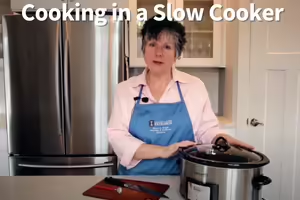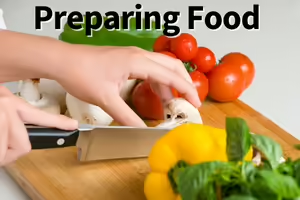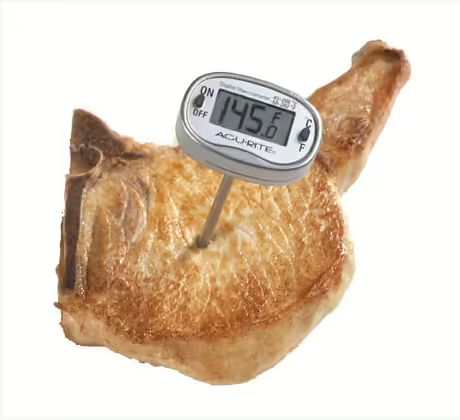Cooking Food Safely
Love to Cook? Let us help make sure your food is prepared safely!
Time and temperature are two of the most important factors when preparing food safely! You cannot see, smell or taste harmful bacteria in food. That's why food safety practices such as handwashing and using a thermometer are essential in preventing foodborne illness. Read about different cooking temperatures, using a thermometer, and additional resources to cook your favorite meal in the safest way.
Cooking Temperatures
Curious what temperature chicken should be cooked to? What about salmon? Find safe food temperatures below, so no one gets sick from a delicious home-cooked meal! Color is not an indicator for safety, always use a food thermometer to make sure foods reach a safe internal temperature.
| Food | Temperature |
|---|---|
| Beef, Pork, Veal & Lamb Steaks, chops, roasts | 145 °F (62.8 °C) and allow to rest for at least 3 minutes |
| Ground Meats, Except Poultry | 160 °F |
| Ground Poultry | 165 °F |
| Ham, fresh or smoked (uncooked) | 145 °F and allow to rest for at least 3 minutes |
| Fully Cooked Ham (to reheat) | Reheat cooked hams packaged in USDA-inspected plants to 140 °F and all others to 165 °F |
| All Poultry (breasts, whole bird, legs, thighs, wings, ground poultry, giblets, and stuffing) | 165 °F |
| Eggs | 160 °F |
| Fish & Shellfish | 145 °F |
| Casseroles | 165 °F |
| All Leftovers | 165 °F |
Find more information about cooking temperatures from the USDA
Food Thermometers
Do I need to use a food thermometer?
Yes. When cooking food the only reliable way to know you've destroyed harmful bacteria is using a food thermometer. Thermometers should also be used when holding food on ice or in a heating element to make sure the food stays below 40 °F or colder or 140 °F or warmer. Additionally, using a thermometer may prevent overcooking.
How do I calibrate a thermometer?
Always follow manufacturers' instructions. There are two safe ways to calibrate a dial gauge thermometer:
Ice Point Method
1. Fill half a glass with ice and the other half with water
2. Insert dial gauge thermometer at least 2 inches into the mixture. Wait 30 seconds.
3. The thermometer should read 32°F, if not, without removing the thermometer from the ice water, adjust the nut under the gauge until it reads 32°F.
Boiling Water Method
1. On a stove, bring a small pot of water to a rolling boil.
2. Carefully place the thermometer at least 2 inches into the boiling water. Wait 30 seconds.
3. The thermometer should read 212°F, if not, without removing the thermometer from the boiling water, adjust the nut under the gauge until it reads 212°.
Cooking Food Resources

Food Safety Tips and Your Crockpot
Watch a short video about food safety and using your slow cooker.
Using a Microwave Safely
Read about cooking in the microwave safely.
Preheating the Oven
Read a blog about if you need to preheat your oven.
